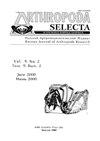长颚蜘蛛在有或没有使用丝的情况下在水中移动
IF 0.7
4区 农林科学
Q4 ENTOMOLOGY
引用次数: 0
摘要
在蜘蛛中,在水生环境中的运动,包括在水面以下或表面膜上的运动,是通过各种不涉及使用丝的技术完成的,包括游泳,行走和划船。利用丝来辅助水中运动的研究只在有限的范围内进行。在这项研究中,我们报告了一种来自澳大利亚的长颚蜘蛛(Tetragnatha nitens)的观察结果,它以两种不同的方式在表面薄膜上移动,其中一种涉及使用丝。第一个观察是一只雌性的T. nitens在受到捕食者的刺激时在水面上行走:蜘蛛用它前面的三对腿来推进,而后面的两对腿在水面上一动不动,可能是为了稳定。第二项观察显示,一只雄性灰尾蚊在水面上滑行时,利用一根丝线将自己卷向新兴的植被。我们的发现支持了对其他长颚蜘蛛的研究,揭示了单个物种可以利用几种策略在水中移动,包括那些涉及使用丝的策略。这项研究揭示了蜘蛛丝卓越的适应性及其在水生系统中的潜在应用。本文章由计算机程序翻译,如有差异,请以英文原文为准。
Long-Jawed Spider Moves across Water with and without the Use of Silk
Among spiders, movement in aquatic environments, including below the water’s surface or on the surface film, is completed using a variety of techniques that do not involve the use of silk, including swimming, walking, and rowing. The use of silk to assist with aquatic locomotion has been explored only to a limited extent. In this study, we report on observations of a long-jawed spider (Family: Tetragnathidae) from Australia, Tetragnatha nitens, moving across the surface film in two different manners, one of which involves the use of silk. The first observation was of a female T. nitens walking across the water’s surface when prompted by a predation attempt: the spider used its front three pairs of legs for propulsion while the back pair remained motionless on the water, likely for stabilization. The second observation featured a male T. nitens utilizing a silk line to reel itself towards emergent vegetation while gliding across the water. Our findings support work on other long-jawed spiders, revealing that individual species can exploit several strategies for moving across water, including those that involve the use of silk. This study sheds light on the remarkable adaptability of spider silk and its potential use in aquatic systems.
求助全文
通过发布文献求助,成功后即可免费获取论文全文。
去求助
来源期刊

Arthropoda Selecta
Agricultural and Biological Sciences-Insect Science
CiteScore
1.60
自引率
33.30%
发文量
44
期刊介绍:
The open-access, peer-reviewed journal is published mostly in English. The scope of the journal is the morphology, taxonomy, development, life histories, zoogeography, phylogeny and evolution of Crustacea, Chelicerata, Myriapoda and other arthropods, both recent and fossil.
 求助内容:
求助内容: 应助结果提醒方式:
应助结果提醒方式:


